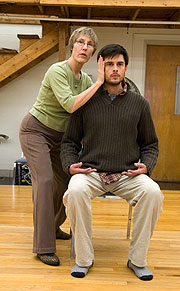  |
| HOME | THIS ISSUE | CALENDAR | GRANTS | BACK ISSUES | < BACK | NEXT > |
Movement ‘re-education’ helps drama students improve performanceby Sherry Fisher - December 3, 2007 | ||||
| Hillary Parker, a UConn graduate student working on a master’s degree in performance, faced a challenge. For a recent Connecticut Repertory Theatre performance, she had to play a character who recites complex lists of information while keeping her body perfectly still. “It was daunting,” she says. But it was not too daunting for Elizabeth Huebner, who trains Parker and other students in the master of fine arts program. Huebner, an adjunct faculty member, teaches the Alexander Technique, a way to use the mind and body to improve movement and performance. “I’m not an actor or a director,” she says. “I’m a movement expert.” Huebner showed the student how to breathe life into an otherwise motionless character. “She helped me be a still presence on stage, that could fill a room for a good 10 minutes,” Parker said. “People were amazed.” Huebner says the Alexander Technique, developed by Australian actor F. Matthias Alexander more than a century ago, “is basically movement re-education.” It helps athletes and musicians as well as actors and people in their everyday lives, use their bodies in ways that promote comfort and ease, instead of moving in ways that create discomfort, she says. “This gives the average person more energy and vitality, and less injury to the neck and lower back.” Classes in the Alexander Technique are required for graduate students in performance. They start taking the course their first semester at the University, and continue until they graduate. Huebner is a certified teacher of the Alexander Technique, who has taught workshops and performed dance in Europe as well as the U.S. She maintains a private practice, and offers workshops throughout Connecticut. She says the Alexander Technique is an important tool for acting students. “Drama students need to have a very agile, powerful, and accurate use of their bodies,” she says. “Their body is their instrument of expression. They need to be able to find a physical neutral and build a character out from there. If they have lots of unconscious habits, they’ll be very limited in the kinds of characters for which they’re cast.” During class on this day, Huebner is working with an acting student who finds it hard to sing in public. She works with his breathing, and the other students offer their thoughts. An actor wants to be able to play the body of any character, says acting student Chris Hirsh.
“To do that,” he says, “you have to get rid of your habits. If you habitually bend forward at the top of your shoulders and protrude your head and neck forward, you have to understand how to correct that. The Alexander Technique helps accomplish that.” Hirsh says the technique also “opens you emotionally. When your body is aligned properly, you become a more open channel to the emotions that may or may not flow out of you. You have fuller freedom of emotional expression.” Huebner says when meeting a new student, or any client, the first step is to find out “what their movement lives are like. Do they spend their days sitting, standing, twisting to file, or in constant motion? “I teach them basic physical landmarks and give them specific information about how the body works in movement. Important landmarks are the major joints, the full length of the spine, and the role of the high and heavy head,” she says. “When the head is well balanced on top of the spine, all movement will be lighter and better coordinated. I then address the hip joints, the strongest weight-bearing joint.” During the first year, students spend a lot of time on what is called constructive rest, which includes breathing exercises and skills to increase awareness of the body and how it moves. Later, they are trained in using the Alexander Technique in their performance. It’s a matter of breaking old habits. “If an actor tightens up his neck and swhoulders every time he needs to speak loudly or with passion, for example, he can learn to lengthen and widen his back to achieve support that doesn’t interfere with vocal production,” Huebner says. Acting student Heddy Lahmann loves the class. “She tells us to ask, ‘What does your body need? Take a survey of what’s going on in your body.’ And then she’ll give hands-on help, touching your neck and your shoulders to release excess tension.” The body carries a lot of tension, Lahmann says, and Huebner knows how to release it into useful energy. “Once we do, there’s a heightened awareness,” Lahmann says. “I can use myself more efficiently to tell a story in a theater where I’m communicating with 500 people.” Huebner also offers the Alexander Technique through the Community School of the Arts. |
| ADVANCE HOME UCONN HOME |

